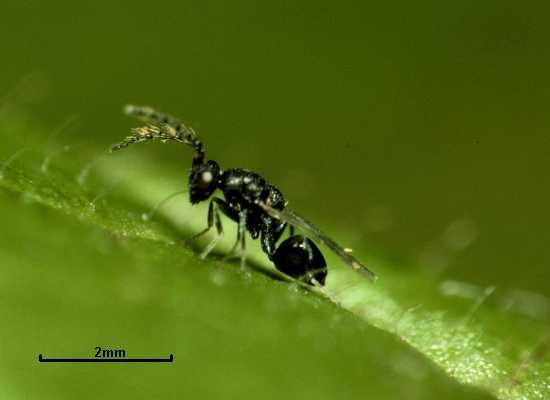The plague of the almond wasp is a fact. On February 28, 2019, the “Diario Oficial de Castilla-La Mancha” has decreed the existence of a plague caused Eurytoma amydali, almond wasp, in the community of Castilla-La Mancha.
It is a hymenoptera insect of the Eurytomidae family, the males usually measure between 4-6mm long and the females between 7-8mm, both are black and elongated. They lay the eggs white, oval in shape and with some protuberances.
When the egg hatches, the larva appears which has a grayish color and it is fed from the almond until it completes its development.
It is during the spring, the date depends on the environmental conditions, when the adults perforate the fruits to cause their exit to the outside, making a hole between 1 and 2 mm in diameter on it.
Once they have left the fruit that had remained in the tree since the previous season, the wasp begins to develop again egg-laying inside the almonds of the new campaign, putting an average of between 50 and 100 eggs , which are divided into several fruits. In addition, before making the egg laying, this insect itches on the stem that joins the fruit to the tree, generating as a kind of glue that makes the fruit stick to the tree more consistently, making it difficult to fall during the period of collection.
The varieties that are most sensitive to this pest are those with the softest and late flowering, among them: Guara, Ferragnes, Penta, etc
This pest can cause damage between 40-80% of the fruits, reducing production by up to 90%. All this has led to the development of a series of exceptional measures aimed at eliminating or reducing this pest completely.
Among the most important is the mandatory application by farmers of plant protection products during the time of emergency of the wasp since the chemical fight is aimed primarily at adults, thus preventing them from making new egg laying. Reaching the egg or the larva is more complicated since they are housed inside the almond.
It is recommended the installation of traps that allow observing the evolution of this insect to be able to program and perform more effectively the application of treatments. And as a cultural measure, it is essential to remove the infected almonds that have remained in the tree of previous campaigns and burn them.
In organic almond plantations, the application of phytosanitary products to combat this pest must also be carried out exceptionally, and the application must be communicated to the control body. In this case, the production obtained cannot be marketed as organic.
Source: Estación regional de avisos agrícolas / Sanidad Vegetal – C.I.A. G El Chaparrillo
Diario Oficial de Castilla-La Mancha.

